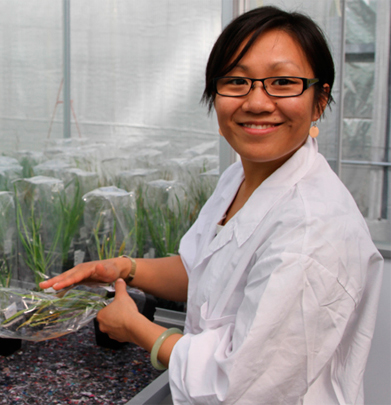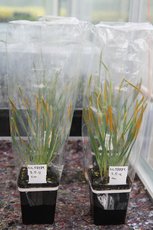The “Stubbs collection” has resolved worldwide diversity of the yellow rust fungus in the past
Two new articles from GRRC -The first is a recovery and a virulence phenotyping study of old isolates from the collection. The second is a SSR marker based study of the worldwide population structure of P. striiformis in the past

In 2010, a unique and historic collection of worldwide Puccinia striiformis samples, often referred to as the “Stubbs collection”, was transferred to the Global Rust Reference Center, Aarhus University, Denmark from Plant Research International, Wageningen, the Netherlands, where it had been developed. The collection was initiated by the Dutch plant pathologist J. C. Zadoks and further developed and maintained by the Dutch plant pathologist R. W. Stubbs.
Currently, approximately 6000 samples of mainly P. striiformis are long-term stored in liquid nitrogen. The collection provides a unique material to study the biology and genetics in the past of the important wheat pathogen. Recovery of a subset of isolates from this collection at GRRC turned out to be very successful (96 % recovery rate) and this enabled a study of the virulence phenotype of old isolates from the collection for the first time.
These results are published in the article:
Thach, T., Ali, S., Justesen, A.F., Rodriguez-Algaba, J. and Hovmøller, M.S. (2015). Recovery and virulence phenotyping of the historic ‘Stubbs collection’ of the yellow rust fungus Puccinia striiformis from wheat. Annals of Applied Biology, 167: 314–326. doi: 10.1111/aab.12227.
The past population structure (1958 - 1991) was investigated by genotyping 212 isolates using 19 multilocus microsatellites. Seven distinct populations were detected, including clonal populations and recombinant populations. These results were compared with recent studies and demonstrated an overall consistent population subdivision at the global scale with clear migration events between populations. The outcome of the study facilitates conclusions about long-term temporal dynamics and overall migration patterns within and among worldwide populations of Pst. These results are published in: Thach, T., Ali, S., de Vallavieille-Pope, C., Justesen, A.F. & Hovmøller, M. S. (2016). Worldwide population structure of the wheat rust fungus Puccinia striiformis in the past. Fungal Genetics and Biology, 87, 1–8. doi.org/10.1016/j.fgb.2015.12.014 |  |
Further information:
Postdoc Tine Thach & professor Mogens S. Hovmøller
Aarhus University, Department of Agroecology, GRRC
E-mail: tine.thach@agro.au.dk & mogens.hovmoller@agro.au.dk
Website: wheatrust.org
Acknowledgement:
This research was supported by the Ministry of Environment and Food - Green Development and Demonstration Programme (GUDP), Innovationsfonden - Denmark, Jordbruksverket in Sweden, Bill & Melinda Gates Foundation, USA, and Department for International Development, Great Britain.